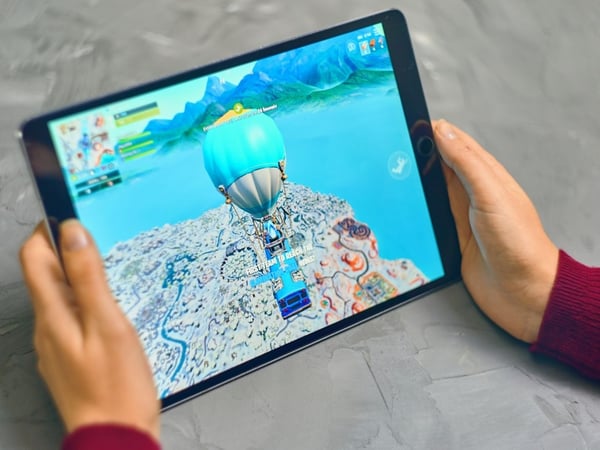Hyper-Casual Games and Your Guide to Marketing Them
by Game Marketing Genie, on 13-Apr-2021 09:36:37
Casual games make a major part of the gaming industry. These games support instant gameplay and are played with simple mechanics such as timing, agility, stacking, and turning. A recent study found that 56.6 percent of gamers consider themselves casual gamers.
Figure 1: The percentage of casual gamers. Source: Limelight Networks
Casual games are mostly played during lunch breaks, or daily commutes, and even on the toilet. And that's why people like them – they are easy to learn, and you can play them anywhere.
Since hyper-casual games are easier to make and have the ability to go viral, many game devs have decided to take this route. If you've developed one of these games or plan to do so, this blog highlights the best hyper-casual game marketing strategies you can use to grow your user base.
What makes a game “hyper-casual”?
Hyper-casual games started as arcade games but can now be accessed on mobile devices. Some users attribute the “hyper” to the games’ fast-paced and addictive nature and associate “casual” to their convenience on mobile devices. Ultimately, these games are simple and need little attention.
Let’s now take a look at the features of hyper-casual games in detail.
Simple to understand
Hyper-casual games are very simple and usually contain just one mechanic. They have no plot inserts, lengthy tutorials, or level selection, and users can access the game within seconds of opening the gaming app. Thanks to the game’s simple gameplay, users can immediately understand what's going on when they access the gaming content.
Instant gameplay
Hyper-casual games offer instant gameplay to their users. They are light with minimal onboarding so that players can instantly tap to play. Their simplicity makes them extremely engaging and addictive.

Minimalistic design
The gameplay is usually very simple, and everything about the game also matches it. The controls, visual, and audio components have a minimalistic design to ensure nothing prevents the user from enjoying the gameplay. The games are designed to be played over short sessions and have a satisfying progression model. Another benefit of hyper-casual games is that they take less space on a user’s device than other gaming apps making them more convenient and less likely to be uninstalled.
Simple monetization
Hyper-casual games are also defined by their target users. While hardcore games target core gamers, hyper-casual games appeal to the mass market. Their ease of understanding and wide accessibility means they can attract a large audience and earn revenue through advertising or a freemium model.
Most common in mobile games
These games are designed to be played anywhere and anytime. Since people are always with their phones, most casual games are designed for mobile devices to increase their accessibility. You can play them as you wait for a friend at a restaurant, when commuting to work in the morning, or to pass time as you wait for your lecturer to get to class.
One of the first games to be classified as hyper-casual was Flappy Bird. The game had a tap-to-play mechanic and a short game session. Its broad appeal made it one of the popular games with 50 million downloads and 6th place ranking on Google’s search trends.
Figure 2: Flappy Bird. Source - Flappy Bird
How to market a hyper-casual game
App stores still don't have an official category for hyper-casual games, but considering the popularity of this genre, this might happen very soon. From iOS game marketing to Android and beyond, as a developer you can implement specific game marketing strategies to attract more users to your game.
Know your target audience
The key to effective video game marketing is to know exactly who you're targeting. Create a portrait of your target users. Define their age, gender, interests, location, and the websites they visit frequently. Hyper-casual games appeal to almost everyone, so you need to segment your audience at a detailed level to ensure you’re reaching them properly with your marketing content.
Undertake competitor analysis
Take a look at your competitors to see what they are doing to promote their games. Evaluate their games as well to identify what makes them unique. Because of how easy hyper-casual games are to make, their market is very crowded, and your game needs to be special to stand out. By analyzing your competitors, you will know how to differentiate your game and draw attention to it.

Establish platforms for the game
The next step for your hyper-casual game marketing is to create a website for your game. This is where customers will come when they need to learn more about your game. Ensure your website is well-designed and properly arranged to make it easy for customers to find what they’re looking for. Some of the things your website should have to include:
- Links to your app store page
- Game’s promo video
- A call-to-action
- Screenshots
- Gameplay trailer
- Reviews
As you plan your online presence, don’t forget to create dedicated social media pages for your game. Find the platforms where your target users spend most of their time and create a profile. Social media will help connect with your audience and build a thriving community for your game.
We have shared the best ways to engage your audience on social media in our blog, Video Game Social Media Management: What It Is and Why It Matters.
Announce your game on your website, socials, and other platforms
Immediately your game is ready for the market, announce it on your website and social media. Those who have been following your development journey will be excited to try it, and this is how you attract people to your game.
Post about on online gaming communities such as developer and gaming channels on Reddit. Also, look for friendly gaming publications or blogs and ask them to feature your game to make more people aware of it.
Add your game to its publishing platform
Whether that’s app stores or elsewhere, add your game to a publishing platform to make it easy for users to get it. Design a beautiful icon to catch the attention of users and describe your game properly to make them fall in love with it. Talk about its features, bonuses and describe some of its best moments. Add interesting screenshots to give players a clue what your game looks like.

Do a soft launch
A soft launch allows you to debug important issues about your game. You may think that your game is perfect at the development stage, but you have to test it to know what people think about it in the real world. Gather the user feedback and use it to improve your game before the actual launch.
Get more information on soft launching in 7 Soft Launch Strategies for Your Mobile Games.
Use referral marketing and contextual advertising
Referral marketing is one of the best ways to get your game out there. People trust their friends' opinions more than in-your-face ads, so you need to encourage your current users to recommend your game to their friends and relatives.
Our blog, Why You Need Referral Marketing For Your Mobile Game, shares actionable tips on how to get your existing users to promote your game within their networks.
Don’t forget contextual advertising when creating your marketing plan. Advertise on app stores to ensure your game is visible when players search certain keywords. Use Google’s ad network to reach your target users when they are online. Engage a gaming marketing agency to create a custom marketing plan for your game.
Use push notifications
Push notifications will help speak directly to the user. They cannot get filtered to spam or forgotten in the inbox. They also remind users to use an app, and this greatly improves the open rates.
For your marketing purposes, you can use push notifications to promote special offers. Users want to get notified about deals, and you can use push notifications for this purpose. FOMO will drive those who haven't signed up for your game to install it to not miss out on all the good things you have in store for app users.
Keep your marketing constant
Your marketing should remain constant all the time. You need it to attract and retain players. Don’t stop marketing your game because you’ve managed to attract a bunch of users. You still need to convince these people to stay and recommend your game to their friends. There are specific marketing strategies for this stage, and the failure to implement them will see you lose players just as fast as you acquire them.

Your top mobile game marketing strategies
Mobile game marketing is your key to the quest for success! Take control of your new game and make its marketing matter with the help of our insider tips in Mobile Game Marketing: Your Complete Guide to Success.
If you want your hyper-casual game to succeed in a sea of similar games, you need to market it well. We have shared some of the hyper game casual marketing strategies you can consider, but you need a custom plan to make your game stand out in the market. The team at Game Marketing Genie can help. Our gaming marketing agency is responsible for growing some of the hottest video games, and we will help your game reach the top charts.
Do you need help to get your game off the ground? Take a look at our marketing strategy for inspiration.


